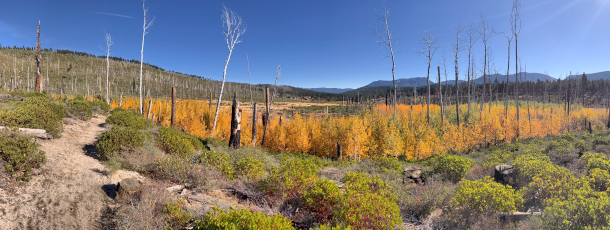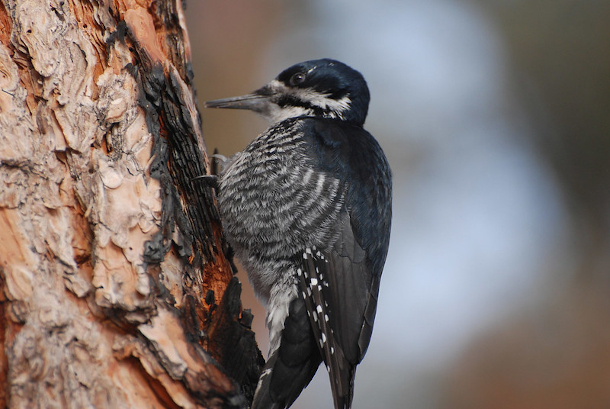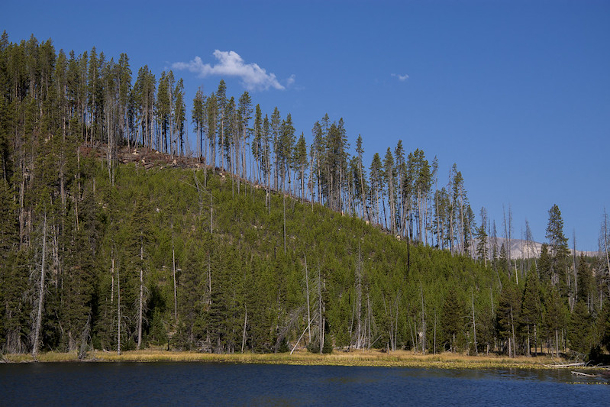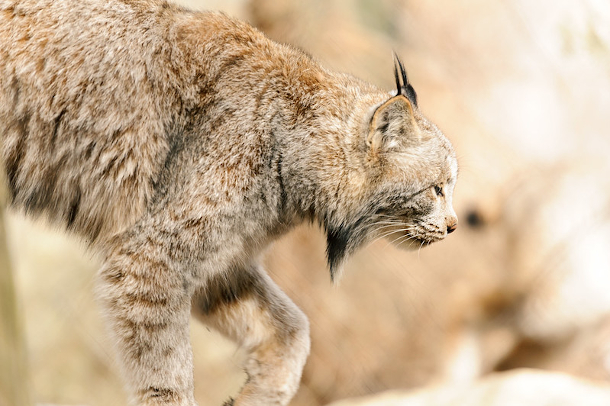How Wildfires Benefit Wildlife
Air Date: Week of October 30, 2020

Aspen recovery in the Angora Fire area near Lake Tahoe, California (Photo: Jonathan Cook-Fisher, Flickr CC BY 2.0)
The record-setting wildfires in the Western U.S. this year have had devastating consequences for the people who have lost their homes and businesses. But as Aaron Scott of Oregon Public Broadcasting reports, many species of plants and animals depend on forest fires to create and maintain the habitat they need.
Transcript
CURWOOD: The record setting wildfires in the Western US this year have burned an area larger than New Jersey, with immense devastation for municipalities and residents. But many species of plants and animals depend on forest fires to create and maintain the habitat they need. Oregon Public Broadcasting reporter Aaron Scott has the story.
GAINES: The trekking poles are helping my old man bones.
SCOTT: Ecologist Paul Hesburgh and Bill Gaines are taking us on a tour through a section of the Washington Cascades that was burned by the Tripod Fire in 2006.
GAINES: Paul, I'm not seeing a lot of woodpecker cavity activity here.
HESBURGH: I haven't seen a cavity all morning or heard any banging.
SCOTT: The reason we're looking for woodpeckers is that they are a poster animal for how scientists like Gaines and Hesburgh are reimagining fire. Instead of seeing fire as a negative thing that needs to be suppressed, they are finding it is essential to the wellbeing of many plants and animals. For example, burned forests may look barren to us. But for wood-eating insects and their predators, they are a feast waiting to happen. Gaines marvels at how woodpeckers just seem to flock in.

Black-backed woodpeckers such as this female thrive in the aftermath of a forest fire (Photo: Mike Laycock, National Park Service, Flickr CC BY-NC 2.0)
GAINES: One thing we don't really know is there's got to be like some woodpecker hotline where they're like, “Come on, everybody! There's a lot of food let's get together and eat!”
SCOTT: And they are far from alone. From aspen to morels, from blackberries to bees. There's an incredible range of plants and animals that thrive in areas touched by fire. One of the best-known examples is the lodgepole pine, which grows what's called serotinous cones.
HESBURGH: And so every cone scale is held together by a drop of resin, and it takes the heat of a fire to melt that resin and cause those cone scales to open up.
SCOTT: The cones shed seeds that quickly grow into dense stands of young trees. And these stands are one of the only hunting grounds for one of the country's most adorable and threatened predators. The Canada lynx.

Lodgepole pine regeneration after a fire (Photo: Kent McFarland, Flickr CC BY-NC 2.0)
GAINES: Okay, so we're gonna pretend we're a cat. We're going to pretend we're a Canada lynx. And what we want to find is our prize food, you know, a snowshoe hare.
SCOTT: Gaines crouches down in stalks his way through the thick branches.
GAINES: You can see here a scat from a snowshoe hare, so we know they've been here. Tells us this is good habitat for snowshoe hare and good habitat for lynx.
SCOTT: That's because these young pines are like a goldilocks zone. They're just right, big enough to provide shelter for the bunnies with branches low enough for them to hide under. But as the pines grow taller and their branches no longer touch the ground, the bunnies and the lynx that hunt them have to go in search of new stands. As Hesburgh explains it, few northwest animals have evolved to live in thick, unchanging forests. Instead, most need an evolving clumpy mosaic of landscapes to meet all their needs. And the main driver behind that constant process of change and renewal is fire.
HESBURGH: If you were to roll the film back a hundred, hundred and fifty years in history and take a look at a big landscape panorama, what you would see is places that were burned yesterday, places that were burned five years ago, ten years ago, that create this variety of habitats.
SCOTT: But decades of fire suppression have transformed that landscape.

The Canada lynx relies on young lodgepole pine stands as perfect snowshoe hare hunting habitat. (Photo: Eric Kilby, Flickr CC BY-SA 2.0)
HESBURGH: Where the forest is all grown up and blended. There are some critters still making a living in that landscape, but it has nowhere near the variety of the former landscape before it was homogenized.
SCOTT: Today's thick forests combined with a warming climate also set the stage for megafires. The result is two starkly contrasting landscapes and a dynamic far different from the one native animals evolved with. Gaines says the loss of that varied habitat for creatures like the Canada lynx has been devastating.
GAINES: Lynx recovery is either made or are not here in this part of Washington. This is the largest population in the lower 48 states.
SCOTT: And it doesn't stop there. Fire has a crazy interaction with water by helping to thin out dense spreading forests, it actually leads to more water flowing into wetlands and streams. That encourages rich cool dining rooms for everything from gear to fish. No one is advocating that we let all fires burn freely, especially the human-caused ones. But a consensus is emerging that as crazy as it sounds, we need to restore regular fire to the land to help our fellow plants and animals survive.
CURWOOD: Aaron Scott’s story comes to us courtesy of Oregon Public Broadcasting.
Links
Living on Earth wants to hear from you!
Living on Earth
62 Calef Highway, Suite 212
Lee, NH 03861
Telephone: 617-287-4121
E-mail: comments@loe.org
Newsletter [Click here]
Donate to Living on Earth!
Living on Earth is an independent media program and relies entirely on contributions from listeners and institutions supporting public service. Please donate now to preserve an independent environmental voice.
NewsletterLiving on Earth offers a weekly delivery of the show's rundown to your mailbox. Sign up for our newsletter today!
 Sailors For The Sea: Be the change you want to sea.
Sailors For The Sea: Be the change you want to sea.
 The Grantham Foundation for the Protection of the Environment: Committed to protecting and improving the health of the global environment.
The Grantham Foundation for the Protection of the Environment: Committed to protecting and improving the health of the global environment.
 Contribute to Living on Earth and receive, as our gift to you, an archival print of one of Mark Seth Lender's extraordinary wildlife photographs. Follow the link to see Mark's current collection of photographs.
Contribute to Living on Earth and receive, as our gift to you, an archival print of one of Mark Seth Lender's extraordinary wildlife photographs. Follow the link to see Mark's current collection of photographs.
 Buy a signed copy of Mark Seth Lender's book Smeagull the Seagull & support Living on Earth
Buy a signed copy of Mark Seth Lender's book Smeagull the Seagull & support Living on Earth

